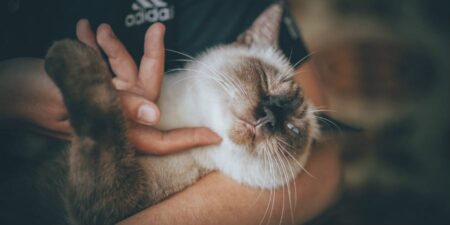Evolutionarily, it’s unlikely that cats could (or someday will) become more intelligent than humans. Intelligence in animals has evolved in response to various environmental pressures and social complexities. The human brain has evolved to its current level of intelligence due to our unique social structure, problem-solving skills, and communication abilities, which required the capacity to process complex thoughts and ideas.
Cats, by nature, are solitary animals with less complex social structures and different survival strategies. Additionally, cats primarily rely on their speed, agility, and stealth abilities rather than complex problem-solving skills or cooperation. Although cats can learn and show signs of intelligence, their evolutionary path is unlikely to lead them to develop a level of intelligence comparable to or surpassing humans.
But this isn’t a complete picture concerning cat intelligence, so let’s address a few other pressing questions.
How Have Domestication and Human Interaction Influenced the Evolution of Cats’ Behaviors and Intelligence?
Domestication and human interaction have significantly influenced the evolution of cat behaviors and intelligence. As cats transitioned from being wild animals to living alongside humans, they faced new environmental pressures and challenges, which led to the development of specific behaviors and adaptations.
Socialization
Domesticated cats are more social and amicable with humans compared to their wild counterparts. They have evolved to form bonds with people, engage in communicative behaviors like purring and meowing, and even exhibit cooperative behavior.
Reduced Aggression and Predatory Instincts
Domesticated cats tend to show reduced aggression and have more subdued hunting instincts, in part because they are not solely reliant on hunting for sustenance. They still maintain some predatory behaviors, like stalking and pouncing, but they usually engage in these activities as play rather than for survival.
Dependency on Humans
Domestic cats have evolved to depend on humans for their basic needs like food, shelter, and comfort. This has allowed them to spend more time resting, playing, and socializing rather than focusing on survival.
Adaptability: Domestic cats are highly adaptable, able to thrive in a multitude of environments by adjusting their behavior accordingly. This ability to adapt may also lead to better problem-solving skills in certain situations.
Learning and Training
Domesticated cats can be trained to perform a range of tasks and follow commands, albeit not as extensively as dogs. This is a result of their interaction with humans, which encourages them to learn from and respond to human cues.
Overall, domestication and human interaction have made cats more sociable, adaptable, and in some ways, more intelligent as they’ve learned to coexist with humans. However, their level of intelligence still largely differs from that of humans, given their unique evolutionary history and survival strategies.
Do Different Cat Breeds Show Varying Levels of Intelligence or Problem-Solving Abilities?
Different cat breeds can show varying levels of intelligence or problem-solving abilities. While breed alone may not be the sole determinant of a cat’s intelligence, certain breed traits and characteristics might make some breeds appear more intelligent or capable in specific tasks compared to others. For example, some breeds may be more amenable to training, adaptable, or possess better problem-solving skills.
Notable breeds known for their intelligence include:
- Siamese: Siamese cats are known for their curiosity, playfulness, and tendency to form strong bonds with their owners. They are also quite vocal and communicative.
- Abyssinian: Abyssinians are praised for their high energy, curiosity, and ability to learn tricks or new tasks. They can be adept at problem-solving and are known to engage in tasks that challenge them mentally.
- Bengal: Known for their active and curious nature, Bengal cats display high levels of intelligence, learning to manipulate objects and engage in puzzle-solving with ease. They are also known for their agility and athleticism.
- Maine Coon: Maine Coons are often described as “gentle giants” and are highly trainable and good problem-solvers. They are known for their sociable and playful nature and can adapt to a variety of environments and family dynamics.
- Burmese: Burmese cats are highly affectionate, sociable, and engaging with their owners. They are intelligent and can be trained to walk on a leash or follow voice commands.
While certain breeds may possess traits associated with intelligence or problem-solving, individual cats within a breed can also display significant variations in their abilities.
Furthermore, intelligence in cats exists on a spectrum and can manifest in various ways, such as social intelligence, adaptability, or problem-solving. Factors such as environment, upbringing, and interactions with people and other animals can also influence a cat’s intelligence and capabilities.
Cat IQ Test (Video)
Do Different Cat Breeds Show Varying Levels of Intelligence or Problem-Solving Abilities?
Cats have an impressive ability to adapt to diverse environments, but their adaptability differs from human adaptability in some key aspects.
Physical adaptations
Cats possess traits such as retractable claws, flexible bodies, incredible balance, and night vision, which allow them to thrive in various ecological settings. These physical adaptations enable them to hunt, climb, and navigate their surroundings effectively. On the other hand, humans rely more on their versatility and ability to manipulate the environment through tools and technology.
Social Structure
Cats are primarily solitary animals, meaning they can navigate their environments without complex social systems. Humans, in contrast, are highly social beings who rely on cooperation and social structure to succeed in diverse environments. Human adaptability also encompasses the ability to integrate into different societies, develop cultural practices, and establish systems of communication that are not as prevalent in cats.
Problem-Solving and Learning
Human adaptability often includes advanced problem-solving skills, the development of technology, and the ability to learn from past experiences. While cats possess problem-solving skills, they are less complex than human skills. Cats focus on immediate issues necessary for survival, whereas humans can tackle abstract problems and plan for the future.
Domestication
Cats have adapted to human-influenced environments mainly through domestication, adjusting to living alongside humans and relying on them for basic needs. This adaptability is focused on coexistence with humans rather than overcoming environmental challenges.
Global Adaptability
While cats can adapt to a variety of habitats, humans have taken this adaptability to the next level, thriving in nearly every corner of the globe, including extreme environments like deserts, polar regions, and high altitudes.
Cats can remarkably adapt to diverse environments due to their physical adaptations and flexible nature. However, human adaptability encompasses a broader range of skills, including social structure, technology, advanced problem-solving, and cultural development, allowing them to thrive in various environments and situations.
What Aspects of Feline Communication, Such as Vocalizations and Body Language, Indicate Intelligence?
Did you know that several aspects of feline communication showcase their intelligence? Cats use an intricate system of vocalizations and body language to convey their needs, emotions, and intentions, displaying their ability to adapt and engage with their environment.
- Vocalizations: Have you ever noticed how cats use a range of meows, purrs, chirps, and hisses to communicate? Different meows can express a cat’s desires, fears, or even feelings of contentment—indicating their understanding and utilization of a basic form of language.
- Body language: Can you recognize a cat’s emotions through its body language? A cat’s position, ear movement, and tail posture can reveal a lot about its emotional state. For instance, a raised tail signifies contentment or excitement, while flattened ears indicate fear or aggression. This demonstrates their ability to convey emotions nonverbally, an important aspect of intelligent communication.
- Social interactions: Do you know how cats communicate with other cats, humans, or animals? Cats can adjust their communication patterns depending on the situation, showing social intelligence. For example, they typically meow more with humans than other cats, adapting their language to interact with us.
- Eye contact and facial expressions: Ever experienced a “slow blink” from a cat and wondered what it meant? Cats use eye contact and facial expressions to convey messages, with slow blinking, for example, being a sign of trust and affection. This level of nuance in communication reflects their cognitive abilities.
- Learning from others: Have you observed how cats watch other animals or humans pick up new communication cues? Cats sometimes learn by observing others, indicating their capacity to adapt communication methods based on the environment—an essential element of intelligence.
The complexity of feline communication through vocalizations, body language, and social interactions reveals their intelligence, highlighting their ability to navigate their surroundings and form connections with others. Isn’t uncovering such depth in our feline companions’ behavior fascinating?
Can Cats Be Trained to Perform Complex Tasks, and if So, What Does This Reveal about Their Cognitive Abilities?
Did you know cats can be trained to perform complex tasks, albeit not as extensively as dogs? This ability to learn and execute tasks showcases their cognitive abilities and provides a window into their problem-solving skills and adaptability.
- Clicker training: Have you ever tried clicker training with a cat? Based on positive reinforcement, this technique can teach cats a wide range of behaviors, from simple commands like “sit” and “come” to more complex tasks like walking on a leash or even jumping through hoops.
- Agility courses: Did you know cats can learn to navigate agility courses with practice and patience? Just like dogs, some cats can be trained to run through tunnels, jump over obstacles, and balance on beams—an indication of their ability to learn, retain information, and respond to cues.
- Task-oriented games: Are you aware that teaching cats to retrieve toys or solve puzzle feeders can display their cognitive abilities? (They can’t play darts, after all.) Cats demonstrate their adaptability and intelligence by learning to associate specific actions with rewards and utilizing problem-solving skills.
- Service and therapy animals: While not as common as dogs, did you realize that some cats can be trained as service or therapy animals, providing emotional support and comfort to individuals in need? This role requires cognitive skills, including adaptability, social intelligence, and the ability to learn commands.
Training cats to perform complex tasks highlights their learning, problem-solving, and cognitive development capacity. So, the next time you interact with a cat, why not consider exploring new ways to engage their minds and tap into their hidden potential?
Conclusion
While cats display remarkable adaptability and unique cognitive abilities, it is unlikely that they will evolve to surpass human intelligence.
Various factors such as social structure, environmental pressures, and distinct evolutionary paths contribute to human and feline intelligence differences.
Nonetheless, exploring the intricacies of feline communication and training capabilities offers fascinating insights into their cognitive world.
"In ancient times cats were worshipped as gods; they have not forgotten this."
-- Terry Pratchett





